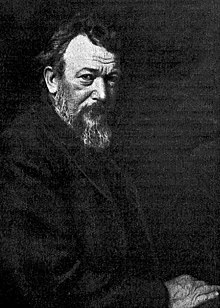Adolf Stäbli
Johann Adolf Stäbli (also Johann Adolf Staebli ; born May 31, 1842 in Winterthur ; † September 21, 1901 in Munich ) was a Swiss painter whose work is counted as part of the German late Romantic period and who was already living in Switzerland and in his adopted home of Munich was especially known for so-called mood landscapes.
Life
Adolf Stäbli was the son of the engraver and drawing teacher Diethelm Stäbli , who came from Brugg in Aargau . At 16 he left high school in Winterthur and got his first education from his father. From 1859 to 1861 he apprenticed in Rudolf Koller's studio in Zurich and, on his recommendation, continued his training with Johann Wilhelm Schirmer at the Karlsruhe Academy of the Arts in 1862 . He became friends with Hans Thoma . Further stations were Dresden , Milan and Paris , where he came into contact with French landscape painting at the World Exhibition in Paris in 1867 and then visited Barbizon . From 1869 he settled in Munich , where he made friends with the Swiss painters Arnold Böcklin and Otto Frölicher and with the art historian Adolf Bayersdorfer . His works have been exhibited in Munich and Switzerland. In 1882 he made a trip to Italy . Stäbli collected his impressions as a sketching outdoor painter in the summer and later painted his pictures in the studio. From 1894 health problems arose from chloroform poisoning and alcoholism , from which he no longer recovered.
plant
Adolf Stäbli is an important representative of landscape painters in the last decades of the 19th century. It is mostly landscapes from his Swiss homeland and those from Upper Bavaria that he presents in his work. Fleeting and dramatic weather phenomena characterize many of his paintings. The moving cloud formations and thunderstorm moods even earned him the reputation of a 19th century Ruisdael . He renounced the picturesque subjects of idealized landscapes of many contemporaries in favor of an immediate emotional, sometimes pathetic experience of nature. His motto was: “My painting is an experience, not an invention.” A commission from the Aargau government, the painting Gathering Thunderstorm in the Aargauer Kunsthaus , completed in 1868, is one of his most famous paintings. He also created drawings , etchings and watercolors . After phases of stagnation, depression and poverty, he found recognition again. In 1897 and 1901 he was awarded gold medals in Munich and in 1898 received the title of professor.
After his death, the main part of his work and estate ended up in Switzerland. His works are mainly in the Aargauer Kunsthaus as well as in other Swiss and some German museums, for example in the Stäblisaal in the Stadtmuseum Brugg, in the Museum Oskar Reinhart am Stadtgarten in Winterthur, in the Kunstmuseum St. Gallen as well as in the graphic collection of the ETH and the Kunsthaus in Zurich ; also in Munich in the Neue Pinakothek , in the Staatliche Graphische Sammlung and in the Städtische Galerie im Lenbachhaus . Retrospectives took place in 1942 in the Aarau Industrial Museum and in 1984 in the Zimmermannshaus in Brugg. Most recently, the Aargauer Kunsthaus honored the artist with a representative selection of landscape paintings in an exhibition from January to April 2015.
Works (selection)
- Forest landscape with a wagon in the background
- Birch trees (birch landscape)
- Romantic landscape
- Italian spring landscape
- Grove of trees by a river
- In the foothills
- Summer riverside game
- Summer landscape with approaching thunderstorm
- Tree in the storm
- Landscape near Oberaudorf
- Fahr Monastery
- Approaching thunderstorm (Brunegg Castle) (1868)
- Chiemsee landscape (1874)
- Landscape by the Water (1878)
- Retreating Thunderstorm (1879)
- Flood (1886)
- At the Amper (1890)
- Crucifix on the way (1894)
- Sturm (around 1895)
- May rain (1896)
literature
- Hans Graber: Adolf Stäbli. His life and work. Basel: Schwabe, 1916.
- Erwin Haller: Johann Adolf Stäbli In: Argovia, annual journal of the Historical Society of the Canton of Aargau. Vol. 65, 1953, pp. 454-464
- Max W. Keller: From letters from Adolf and Adèle Stäbli to Gottfried Felber. In: Brugger Neujahrsblätter. Vol. 53, 1943, pp. 31-40.
- Walther Siegfried: Adolf Stäbli as a personality. In: Schweizer Illustrierte , Vol. 6, 1902, pp. 137–151.
- Adolf Stäbli . In: New Year's Journal of the Art Society in Zurich . 1903.
- Adolf Stäbli 1842–1901. A Swiss landscape painter in Munich. Brugg, Galerie Zimmermannshaus, 1984. Catalog: Marc-Joachim Wasmer, Barbara Müller. Aarau / Stuttgart: AT, 1984.
- Adolf Stäbli. “My painting is an experience, not an invention”. Edited by Thomas Schmutz and Aargauer Kunsthaus. Zurich: Scheidegger & Spiess, 2015 ( information on the exhibition ).
Web links
- Marc-Joachim Wasmer: Stäbli, Johann Adolf. In: Sikart (as of February 24, 2015)
- Stäblisaal and historical collection in the Brugg City Museum , website of the City of Brugg
| personal data | |
|---|---|
| SURNAME | Stäbli, Adolf |
| ALTERNATIVE NAMES | Stäbli, Johann Adolf (full name); Staebli, Johann Adolf |
| BRIEF DESCRIPTION | Swiss landscape painter |
| DATE OF BIRTH | May 31, 1842 |
| PLACE OF BIRTH | Winterthur |
| DATE OF DEATH | September 21, 1901 |
| Place of death | Munich |



